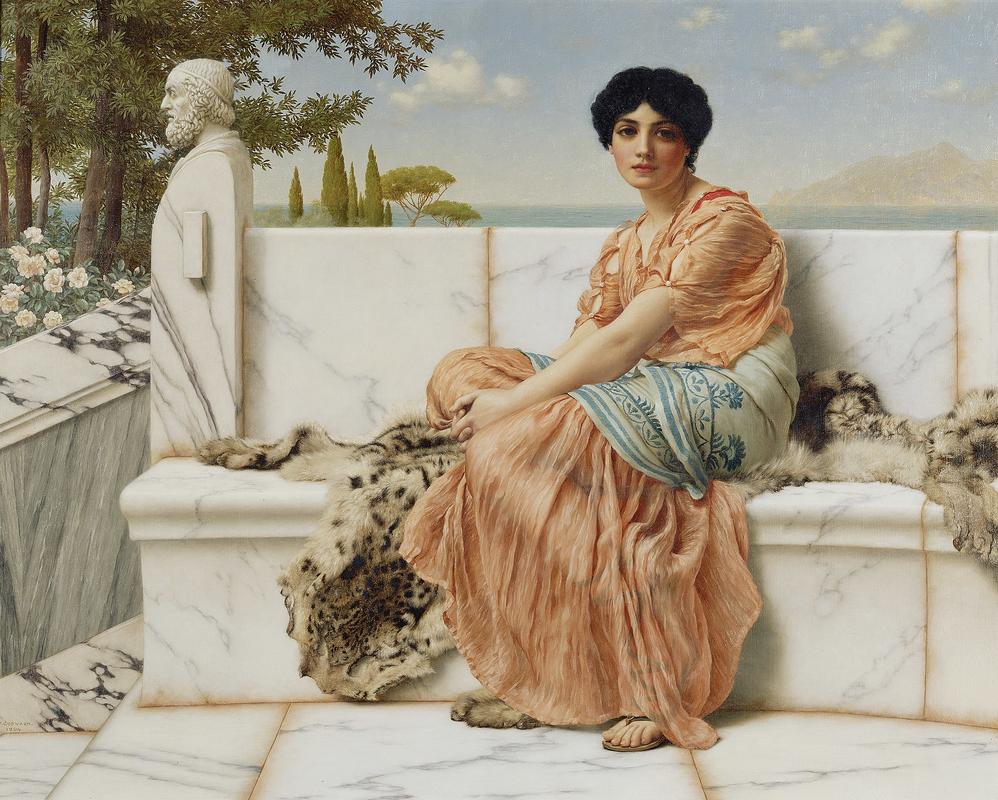More about Reverie
- All
- Info
- Shop

Contributor
John William Godward was trained in the Neoclassicist style by Sir William Alma-Tadema, and the man never let him forget it.
Every last one of his works calls back to Greco-Roman times. However, while his hand almost allows the work to jump off the canvas, there are details that break the illusion. The cloth wrapped around her hips was never worn in ancient times. The palmette design was a feature found on architecture and ceramics during Ancient Greek times, but not on textile work. The spotted fur that the woman is sitting has no real correlation to any animal, mythical or in real life, and serves just for Godward’s love of juxtaposing textures on top of one another. Like Zack Snyder’s approach to the 300 Spartans at Thermopylae or Oliver Stone’s approach to the life of Alexander the Great, Godward has come under fire for inaccuracy.
Reverie is another in a long line of paintings upon which Godward has expressed a fixation toward brunettes. Considering how shy and reclusive he was in his day, could he be basing his figures on someone? A lost love, like Dante’s Beatrice, perhaps?
As a member of the “Marble School,” Godward embodied Neoclassicism within every last one of his portraits, with a realism so dedicated you could almost feel the cold smoothness of the stone the delicately clothed women in his portraits sit upon.
However, it all came at the worst possible time. Neoclassicism was a style that was very much in vogue in the last half of the 1700s. By 1904, more abstract styles such as Impressionism, Expressionism, and Cubism came on the rise, leaving Godward’s work as old relics, belonging to a man born two-hundred years too late.
In parallel to the Greek epics and tales of old, Godward’s life was tragic in both upbringing and in demise. One could say that this work, along with many of his other antiquity-style portraits, was his way to cope with the rapidly modernizing world.
Sources
- Gontar, Cybele. 2003. “Neoclassicism.” The Met's Heilbrunn Timeline of Art History. The Metropolitan Museum of Art. October 2003. https://www.metmuseum.org/toah/hd/neoc_1/hd_neoc_1.htm.
- “John William Godward.” n.d. Heritage Auctions. Accessed November 24, 2018. https://fineart.ha.com/artist-index/john-william-godward.s?id=500031752….
- “John William Godward (English, 1861 - 1922) (Getty Museum).” n.d. The J. Paul Getty Museum. J. Paul Getty Museum, Los Angeles. Accessed November 24, 2018. http://www.getty.edu/art/collection/artists/608/john-william-godward-en….
- Muscato, Christopher. n.d. “Palmette Design: Egyptian, Greek, & Roman.” Study.com. Study.com. Accessed November 24, 2018. https://study.com/academy/lesson/palmette-design-egyptian-greek-roman.h….
- “Reverie (Getty Museum).” 1970. The J. Paul Getty Museum. J. Paul Getty Museum, Los Angeles. January 1, 1970. http://www.getty.edu/art/collection/objects/691/john-william-godward-re….












